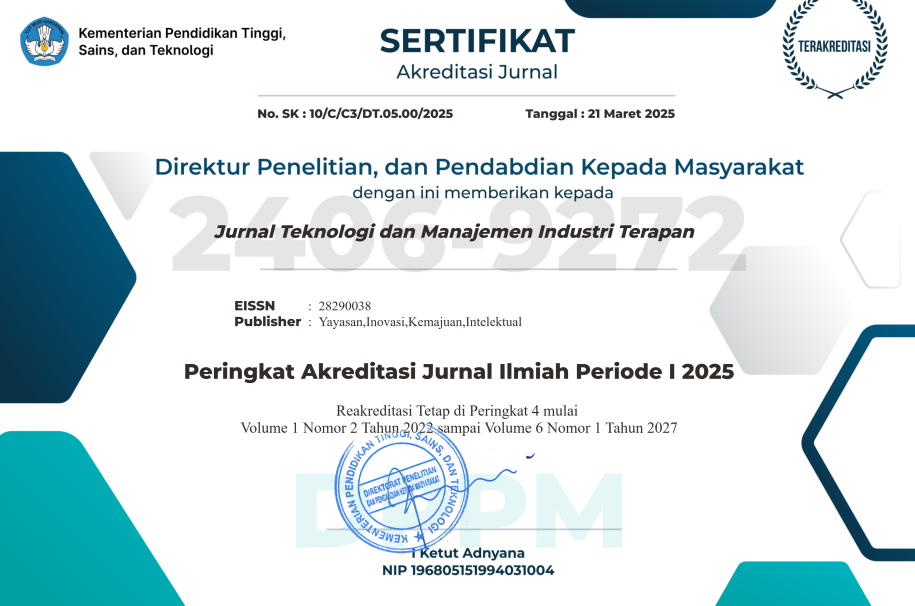Integration of Spatial Finance-Multi Criteria Decision Analysis with Monte Carlo Risk Simulation for Measuring Credit Risk in the Fisheries Aquaculture Sector
DOI:
https://doi.org/10.55826/jtmit.v4i3.956Keywords:
Aquaculture, Spatial Finance, Credit RiskAbstract
Indonesia's aquaculture industry has substantial economic potential, but it faces considerable credit risk from natural disasters like floods, which lead to high Non-Performing Loans (NPLs). Current methods for assessing credit risk do not adequately consider geographical risk factors. This research addresses this by developing a model to quantify flood-induced credit risk. The model integrates a Spatial Finance approach, Spatial Multi-Criteria Decision Analysis (AHP-GIS), and Monte Carlo risk simulation. Using a case study of flood-related credit losses from 2020 to 2022 in Kampar Regency, Riau, the model effectively maps flood vulnerability zones by weighting geospatial criteria through AHP. Key findings indicate that incorporating spatial factors significantly influences loss predictions. Credit portfolios in high flood risk areas show a maximum estimated loss (Value at Risk - VaR) that is 4.67% higher compared to traditional assessment scenarios. Therefore, this model provides a measurable tool for financial institutions to adjust credit portfolios, implement location-specific risk reduction strategies, and ultimately improve financing stability in the aquaculture sector.
References
Kementerian Kelautan dan Perikanan, “Analisis Indikator Kinerja Utama,” Apr. 2024.
A. Rizyamesa and R. A. Rahadi, “A Conceptual Model Of Credit Scorecard In Productive Loan,” Advanced International Journal of Banking, Accounting and Finance, vol. 2, no. 4, pp. 25–41, Sep. 2020, doi: 10.35631/aijbaf . 24003.
S. Mitra, M. A. Khan, and R. Nielsen, “Credit constraints and aquaculture productivity,” Aquaculture Economics and Management, vol. 23, no. 4, pp. 410–427, Oct. 2019, doi: 10.1080/13657305.2019.1641571.
B. Caldecott, M. McCarten, C. Christiaen, and C. Hickey, “Spatial finance: practical and theoretical contributions to financial analysis,” Journal of Sustainable Finance and Investment, 2022, doi: 10.1080/20430795.2022.2153007.
R. F. A. Elsheikh, S. Ouerghi, and A. R. Elhag, “Flood Risk Map Based on GIS, and Multi Criteria Techniques (Case Study Terengganu Malaysia),” Journal of Geographic Information System, vol. 07, no. 04, pp. 348–357, 2015, doi: 10.4236/jgis.2015.74027.
G. Assaf, “Optimal Preventive Maintenance, Repair, and Replacement Program for Catch Basins to Reduce Urban Flooding: Integrating Agent-Based Modeling and Monte Carlo Simulation,” Sustainability (Switzerland), vol. 15, 11, 2023, doi: 10.3390/su15118527.
K. M. M. Adnan, Z. Xicang, M. A. Khan, S. A. Sarker, and A. Rahman, “Catastrophic risk perceptions and attitudes in aquaculture: Evidence from flood-prone areas of Bangladesh,” International Journal of Disaster Risk Reduction, vol. 100, Jan. 2024, doi: 10.1016/j.ijdrr.2023.104203.
Md. A. Alam and A. G. Guttormsen, “Risk in aquaculture: farmers’ perceptions and management strategies in Bangladesh,” Aquaculture Economics & Management, vol. 23, no. 4, pp. 359–381, Aug. 2019.
T. V. Nguyen, T. Q. Tran, and D. Ahsan, “Aquaculture Farmers’ Economic Risks Due To Climate Change: Evidence From Vietnam,” European Journal of Business Science and Technology, vol. 8, no. 1, pp. 42–53, 2022, doi: 10.11118/ejobsat. 2022.006.
B. Caldecott, M. McCarten, C. Christiaen, and C. Hickey, “Spatial finance: practical and theoretical contributions to financial analysis,” Journal of Sustainable Finance and Investment, 2022, doi: 10.1080/20430795.2022.2153007.
D. Donaldson and A. Storeygard, “The view from above: Applications of satellite data in economics,” Sep. 01, 2016, American Economic Association. doi: 10.1257/jep.30.4.171.
E. Mokhtari, F. Mezali, B. Abdelkebir, and B. Engel, “Flood risk assessment using analytical hierarchy process: A case study from the Cheliff-Ghrib watershed, Algeria,” Journal of Water and Climate Change, vol. 14, no. 3, pp. 694–711, Mar. 2023, doi: 10.2166/wcc.. 2023.316.
F. A. F. Ferreira, S. P. Santos, and V. M. C. Dias, “An AHP-based approach to credit risk evaluation of mortgage loans,” International Journal of Strategic Property Management, vol. 18, no. 1, pp. 38–55, 2014, doi: 10.3846/1648715X.2013.863812.
G. Yadav, “A fuzzy AHP approach to prioritize the barriers of integrated Lean Six Sigma,” International Journal of Quality and Reliability Management, vol. 34, no. 8, pp. 1167–1185, 2017, doi: 10.1108/IJQRM-01-2016-0010.
H. Pandey, “Identification and ranking of enablers of green lean Six Sigma implementation using AHP,” International Journal of Productivity and Quality Management, vol. 23, no. 2, pp. 187–217, 2018, doi: 10.1504/IJPQM.2018.089156.
G. Yadav, “Prioritising solutions for Lean Six Sigma adoption barriers through fuzzy AHP-modified TOPSIS framework,” International Journal of Lean Six Sigma, vol. 9, no. 3, pp. 270–300, 2018, doi: 10.1108/IJLSS-06-2016-0023.
M. Sari, “Perbandingan Tiga Metode Pengukuran Var Portfolio,” Oct. 2024. [Online]. Available: https://www.researchgate.net/publication/384958754
M. Babister, M. Retallick, M. Loveridge, I. Testoni, C. Varga, and R. Craig, “A Monte Carlo framework for assessment of how mitigation options affect flood hydrograph characteristics,” Australian Journal of Water Resources, vol. 20, no. 1, pp. 30–38, Jan. 2016, doi: 10.1080/13241583.2016.1145851.
I. L. Kadigi et al., “An economic comparison between alternative rice farming systems in Tanzania using a Monte Carlo simulation approach,” Sustainability (Switzerland), vol. 12, no. 16, Aug. 2020, doi: 10.3390/su12166528.
Y. Chen, Z. Wang, and Z. Zhang, “Mark to market value at risk,” J Econom, vol. 208, no. 1, pp. 299–321, Jan. 2019, doi: 10.1016/j.jeconom.2018.09.017.
Downloads
Published
Issue
Section
License
Copyright (c) 2025 Muhammad Rasyid Ridho, I Ketut Gunarta, Iwan Vanany

This work is licensed under a Creative Commons Attribution-NonCommercial-ShareAlike 4.0 International License.


















